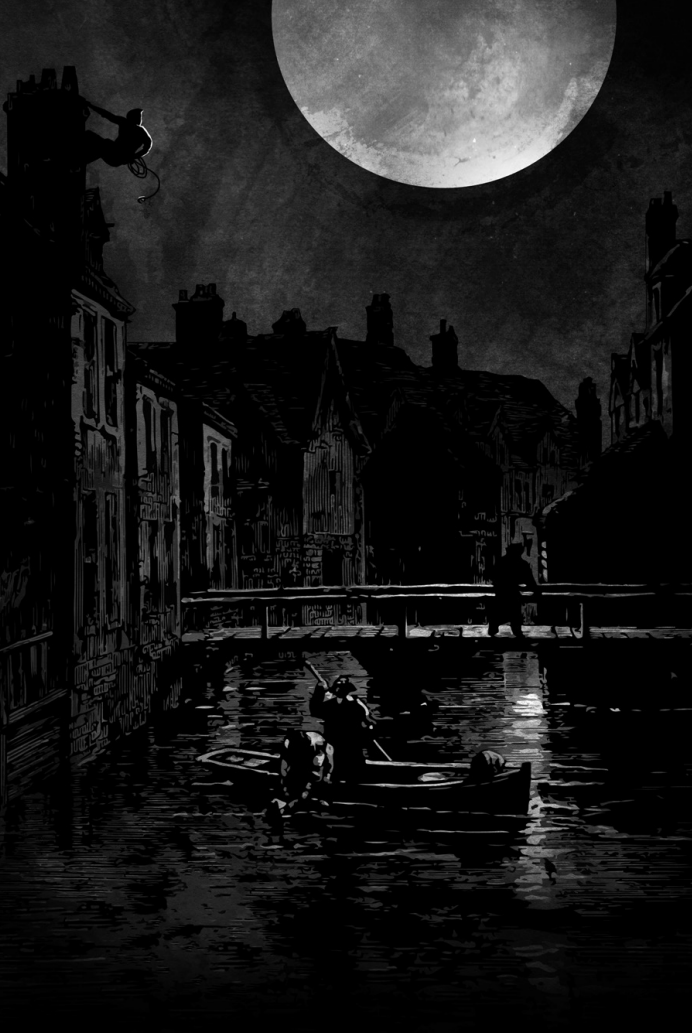Blades in the Dark Overview
What is Blades in the Dark?
Blades in the Dark is a tabletop fantasy role-playing game by John Harper in which players embrace the roles of daring scoundrels seeking their fortunes in the haunted, industrial-fantasy city of Doskvol. Players must face the challenges of rival factions, vengeful spirits, the city watch, their character's unique vices, and whatever else the city can throw at them as they attempt to pull off dangerous scores.
The Player Characters
The players of the game each create their own character according to one of the character playbooks. They can choose to create a cutter, a hound, a leech, a lurk, a slide, a spider, or a whisper. Each type of scoundrel comes with their own unique skills and specialties. According to the rulebook:
- Cutters are intimidating fighters.
- Hounds are deadly sharpshooters and trackers.
- Leeches are tinkerers, alchemists, and saboteurs.
- Lurks are stealthy infiltrators.
- Slides are manipulators and spies.
- Spiders are devious masterminds.
- Whispers are arcane adepts.
The Crew
Once the players have created their characters, it's time to bring the characters together to form the crew. Just like the player characters, the crew gets its own character sheet to track the crew's attributes. When creating the crew, the players decide on a crew type, which generally describes what types of activities the crew will engage in. The players can choose to be assassins, a cult, bravos, hawkers, smugglers, or shadows.
- Assassins are killers for hire.
- A Cult serves a forgotten god.
- Bravos are thugs and extortionists.
- Hawkers sell illegal products.
- Smugglers transport contraband.
- Shadows are thieves and spies.
The Game Master
Like in other tabletop role-playing games, the game master takes on the role of establishing the setting of the game. They will play any non-player characters, depict the environment to the players, and describes any consequences that result from the players' actions.
What does a game of Blades in the Dark look like?

Like in other tabletop role-playing games, the GM takes on the role of establishing the setting of the game. They will play any non-player characters, depict the environment to the players, and describes any consequences that result from the players' actions.
During a session, the crew of scoundrels decide what the target of their score will be, what type of score it will be (assault, deception, stealth, occult, social, or transport), and then with one dice roll they jump straight into the action. The GM will describe the environment to the players, including taking on the roles of any non-player characters and detailing the setting and any obstacles the crew might face. The players will then embody their characters and react to the situation at hand. Whenever a scoundrel takes an action that is particularly dangerous or risky, the player will make an action roll to determine how well that action succeeded or how badly it failed. Then the GM will determine what the consequences of that action might be based on the result of the roll.
It is more likely than not that there will be some sort of consequences for an action. These consequences could take the form of harm, stress, a complication, or a loss of opportunity to name a few. In Blades in the Dark, it's not a matter of if something goes wrong, but when something goes wrong, and that's part of what makes this game so exhilarating.
Once the score is complete (successfully or not), the game enters the downtime phase, during which the characters get a break between scores to rest, relieve stress, recover, and work on long-term projects. After downtime, the players can start picking out the target for their next scheme.